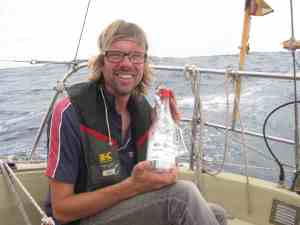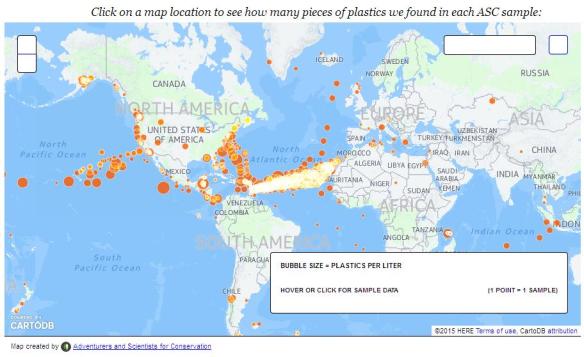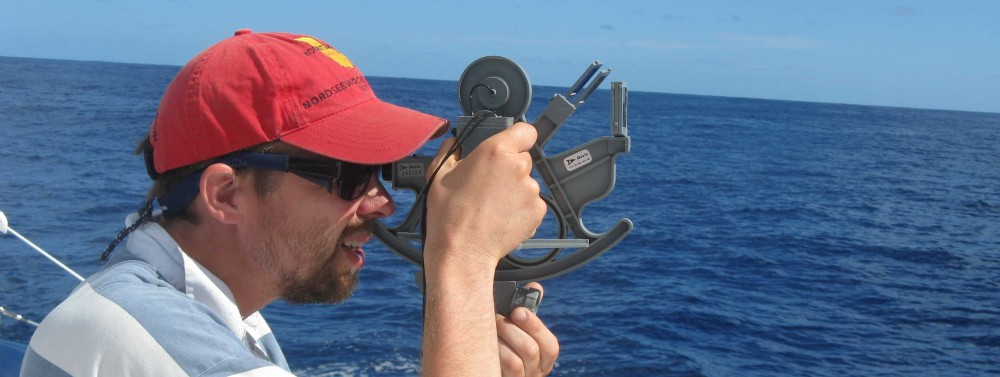
Under spinaker on the Atlantic Ocean towards the Carribbean
Marcos was the first 10 days almost completely, at least mentally, occupied with a report about his PhD he had to send in by the 2 February. So he made also Sören and me work on it by either lending him a computer, or the satellite phone to communicate with his professors or friends or the administration of his university or by running the engine to charge his computer or to ask sometimes what we thought about certain aspects.
But let us begin at the start. We left Mindelo on 22. January in the afternoon on a sunny and as usual quite windy day. When we backed off from the pontoon we caught one of the mooring lines behind the skeg and I had to dive to free it. But that was quickly done. At first we had only half the genoa and no main sail. Only from the second day we added the main sail after the wind had gone down. That were for most of the time our sails.
On the fourth day we heard the thunder of a distant thunderstorm but we also saw it coming closer so we prepared for it. We got the main sail down and reefed the genoa to one third of its size, everybody got his foul weather gear on (Segelkleidung) life jacket and life line and I disconnected all radio antenna cables. Luckily the thunder storm just passed by with only a little increase of the wind.
During the next night and day and the night after this day we saw in the very distance and sometimes up in the clouds lightning but never heared the thunder but in the night of the fourth day we had almost all the time a light rain. Unfortunately it was not enough to rinse off the salt from our clothes and the deck but it was enough to make everything wet.
Luckily after that we did not have any rain or thunderstorms any more, it got gradually every day warmer and warmer. At the beginning it was 21°C in the night and we were wearing our sailing jackets and trousers and several pullovers but later it was also at night 25°C warm and the wind was lighter so one pullover without a jacket was enough. Because there were no clouds we had beautiful moon lit nights.
On 30.January, my birthday we also had arrived in the middle of the distance so we had two good reasons to celebrate and opened a bottle of sparkling wine. Despite it was not cooled because we did not run the fridge to save electricity, we enjoyed it.

Birthday and half way celebration
Our 24-hour distances varied between 150 nm on the best days and 80nm on the worst days when the wind was especially calm but on the average it was somewhere between 110nm and 130 nm.

The SeaBelow crew showing their respect to their captain

When Marcos was not writing on his text he was practicing on his guitar

and he was making fun of the sea weed that was floating around us everywhere

We used to have our lunch at 16:00 because until 12 always somebody was sleeping and it is not nice to start your day with a lunch. You rather want a breakfeast. So during the afternoon everybody is awake and nobody is disturbed when a meal is cooked. And because the cooking takes time and to leave some time between the last one´s breakfeast 16:00 turned out to be a good time. It was then also possible to wash the dirty dishes before sunset which was usually around 6:30, depending on how we decided to set the clock.

From almost the first day one of the highlights during the day was the daily radio round on SSB (Single Side Band) (Kurzwellenfunkgerät) with several other fellow German sailors but namely with the reliable Dietmar on his saling yacht Summer on the Canary Islands. He always provided us with the latest weather forecast. This way of communication had two advantages. The first is it is nice to talk to somebody out in the world so you do not feel so alone on the big wide ocean and secondly it saved me from starting my laptop and setting up the satellite phone to get a weather forecast by e-mail which also costs money for the phone connection. Sometimes other yachts participated and often people sitting in Germany, e.g. in Dresden, telling about the winter weather in Germany and we made them envious with the weather we had. It is incredible to have a conversation with a group of people thousands of kilometres apart. E.g. from Dresden to the Canary Islands it is 3800 km and from the Canary Islands to us was 4700km, so from Dresden to us it was 8500km. And the quality was better than on skype in the respect that the connection was not disconnected as it with skype often happens due to poor internet. Although it has to be admitted that on SSB the conditions were varying and not always a good communication was possible, sometimes impossible. But then often someone in between could make a relais, meaning he or she passes the information on. So all in all I am happy that I made the effort in Las Palmas to get my SSB working and therefore thanks again to Alfred Deubler who told me how to do it and who repaired the actual SSB radio.
In the last third of the journey it go really tropically hot with over 30°C during the day and not less than 25°C at night so we were only wearing shorts and taking a shower with sea water every day. We were soon run out of sun screen (Sonnencreme).
Talking of which, we were a bit short on fresh fruits and vegetables. They were almost all gone after the first ten days but we still had potatoes, yams (Süßkartoffeln) and onions. We also should have bought more eggs. But that are only side aspects and luxury problems.
What do you do all day on the ocean? Good question. First of all you have your watches which make up 7 to 10 hours of the day, depending on which watch you have. We used the so called Swedish watch system where you have watches of different lengths. As on the leg from the Canary Islands to the Cape Verde Islands we had 4 hours during the day and 3 hours at night.
So after sleeping you get up and have breakfast. That takes up to two hours, because such a simple thing as to heat the water for coffee or tea takes time because every hand move has to be planned because nothing stays in its place. Also filling the cup with coffee, milk and sugar needs a lot of thinking and routine. First you put in the sugar because it is not much volume in the cup and does not spill when the cups moves, then you put in the milk, which also is not so much volume and then you add the coffee to fill up the cup to the possible maximum and then you have to keep in your hand until it is empty. The possible maximum is determined by your ability to balance the cup in one hand while climbing up the companion way (Niedergang) with the other hand. If you filled the cup too much, the sea takes its share and you have to clean up the mess afterwards. To eat we often had muesli or porridge which of course had to be prepared before the coffee because with a cup of coffee in your hand you can do nothing else any more. Porridge was more useful because it is thicker than muesli where the milk could still easily spill when the boat was heeling (Krängen) over.

Frying pancakes

Salad (note the pullover, this is a picture from the first half of the trip. Later is was so hot that during the day we were not even wearing a t-shirt)
Then there was navigation to be done, either by plotting the position from the GPS into the sea chart or as in my case I enjoyed to determine our position also by sextant which again involves a lot of skilled climbing on the boat with the precious high precision sextant in your hand. You don´t want to drop it nor to hit it somewhere. And if you know how often you hit your own elbows, knees and head somewhere you can imagine what a stressful action it is to climb with a sextant in your hand over deck to a place where you can see the sun and the horizon without an guard rail or the sails obstructing the view.

Ready to measure the angle between the sun and the horizon with the sextant.

And the result is: 54°45`
The the daily rigg check where I checked the conditions of the shrouds (Wanten) to make sure no damages leading to the loss of the mast remain undetected.

During the daily rigg check. Here I am checking the shrouds (Wanten) and the screws (Spannschrauben)
Then we had to empty the water out of the bilge every day, cooking dinner took two hours for cooking and one hour cleaning up and often something small has to be repaired like the locking mechanism of the front hatch.

Doing little repairs

And yes, then I collected six samples of sea water to be analysed for how much micro plastic it contains. Microplastic are all plastic particles smaller than 5mm which means also the ones that are so small that we can not see them any more but which are still in the oceans. Plastic waste is one of the biggest environmental problems of ocean pollution of which unfortunately most people are unaware. Plastic that has found its way into the ocean is rubbled to microscopic small pieces by the sunlight and the movement of the waves. Sea animals like fish eat the plastic and by this way enters the food chain.
And for us sailors the plastic comes quite directly into our food when we cook our potatoes with sea water or wash our dishes with sea water. Reason enough to be concerned about the problem. I collected the samples for an initiative called “Adventurers and Scientists for Conservation” which resides in Stonington, ME in the USA. The bottles with the sea water will be sent there by mail and they analyse them and by that they get an overview where how much micro plastic is in the water.
I learned about the project from Marjo and Edwin and their organisation “Ocean Conservation” in Las Palmas. They had already supplied 100 sailing yachts of the ARC 2014 with six sample bottles each.

Rinsing the bucket to take a sample of micro plastic water. Because the bucket and the bottles are of plastic themselves they have to be rinsed before taking a sample to make sure to micro plastic particles from the bottle or the bucket end up in the sample. So first the bucket is rinsed three times, then the bottle three times and then the actual sample is taken. So the bucket is filled seven times. The bucket is necessary because the deck is too high over the water that you can not reach it with your arm, even me with my extra long arms can not reach it.

Every bottle got a label stating the date,, number of the sample and the ships name. In list the position, water temperature, wind strength and direction were added.
So, long story short, there is a lot to do and no real boredom. We read our books, look into the waves, sometimes we see flying fish, once we saw one or two whales passing by in the opposite direction. Sometimes sea birds show up and we ask ourselves how they can survive so far away from land. How do they for example drink? Where to they find sweet water? In the sea weed (Seetang) which is floating around everywhere on the last third of the trip?

A picture of the patches of sea weed that were floating around all over the ocean during the second half of the journey.
We opened a second bottle of sparkling wine after Marcos had sent away his text on 2. February because now we where relieved from the stress he was creating and also he himself felt very relieved because only now he could start to enjoy the trip.

Marcos at a typical task. Phoning via satellite phone to his university colleagues to arrange things for his paper.
One day we had very little wind and there was a lot of sea weed caught behind the skeg and we decided to the boat by taking the sails down and take a swim in the ocean using the occasion to clean off the sea weed from the skeg. But actually it had already fallen off when we had stopped the boat.

Online in the middle of the ocean

Marcos with sea weed on his head (no further comment)

It is really a big joy to take a swim in the middle of the ocean.
The journey went on with light winds which brought us around 110 to 120 miles per day, the nights usually moon lit and clear. Only the last two days we had an overcast sky and some drizzling rain.

One of the many sunrises and this was the last one at sea.

A rainbow (under the boom) after light rain during the sun rise
On the last day of sun I had very successfully got a position using the sextant. Successfully means the position I got was only 4,7 nm differing from the GPS position. But when I tried it a second time three days later when the sun had come back after the rain I got it 100 nm wrong. So I need to practice much more to make it reliable.
Two days before we reached St. Lucia we printed the SeaBelow name and logo onto shirts for Marcos and Sören.

Applying ink to the sieve to print the SeaBelow logo and name onto t-shirts for Marcos and Sören

The ready print

Drying the ink on the guard rail
We had hoped to make land fall on 8. February before sun set but due to the light winds we were not quick enough. Instead we were rewarded with a nice sunset over St. Lucia.

The last sunset at sea with St. Lucia already visible at the horizon.

The proud skipper and equally proud crew on the morning after arrival.

At anchor in Rodney Bay with St. Lucia in the back ground.
So it got night but I was not worried to arrive at night because I knew the place and that there were no navigational obstacles except the other anchoring boats. Normally everyone should set an anchor light but not everybody does so when approaching the anchorage we had to be very careful to detect the unlit boats. Eventually we arrived at 1 a.m. local time on 9th February in the Rodney Bay of St. Lucia where we dropped the anchor and then just slept.
The next morning we were very curious to see how the bay looks like. It is all green, many other boats anchored there and we took a swim.Afterwards we went into the marina to get rid of the rubbish, wash our clothes, stock up with food and water and to register at the immigration office.
On arrival at the pontoon we met two Germans with their catamaran Blue Note who I had met before in Lisbon. That was a very nice coincidence.




































































